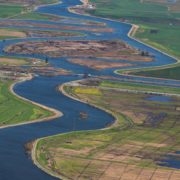Following the driest three-year period on record, California experienced one of the wettest three weeks in January. But now those extreme wet conditions have activated a water quality standard in the Delta that, coupled with the extended dry period since then, could result in a sharp reduction in the amount of water that can be retained or moved into storage for both the State Water Project and federal Central Valley Project.
The Department of Water Resources and the U.S. Bureau of Reclamation are working in real time to operate the state’s water system to maximize water supply while protecting species and the environment. However, California continues to experience unprecedented swings in weather impacting water management operations.
“Extreme weather swings”
Because of these extreme weather swings, DWR and Reclamation are taking proactive measures to manage the state’s water supply to store and capture more water in preparation for a return to hot, dry weather in the next two months.
Both agencies submitted a Temporary Urgency Change Petition (TUCP) to the State Water Resources Control Board requesting approval to modify compliance with Delta water quality conditions specified in their water right permits, while proposing measures to avoid impacts on Delta smelt.
DWR and Reclamation typically would seek this kind of change during extremely dry conditions. But the swing to extremely wet conditions after extremely dry conditions has created challenges, and the projects are acting to enable additional opportunities for water storage north and south of the Delta while maintaining protections for species.
The request for the TUCP follows protective actions taken by DWR and Reclamation under state and federal endangered species permits in late December and early January, including the “first flush” action to reduce pumping and allow storm runoff to flow through the system for the benefit of native fish species. Recent monitoring information shows the actions worked as intended, with key fish species moving downstream of the Delta and away from the direct influence of the SWP and CVP pumps.
The water quality and water right permits that dictate SWP and CVP operations require certain water quality conditions to be met at specific compliance points in the Delta to provide for favorable conditions for endangered fish species. In consultation with the Department of Fish and Wildlife, DWR and Reclamation are requesting that the State Water Resources Control Board temporarily move the compliance point in the projects’ water rights permits from Port Chicago six miles east to Chipps Island. The alternative compliance point is anticipated to ensure water quality sufficient to protect beneficial uses.
Drought conditions persist
If approved by the State Water Board, these actions would allow DWR and Reclamation to move and retain more stormwater and runoff in the state’s reservoirs in preparation for continued dry periods. A total of approximately 300,000 acre-feet would be saved for later use by the State Water Project alone.
While the January storms provided much-needed rain and snowfall, they did not end drought conditions for much of the state and California remains in a drought emergency. Regions that rely on the Colorado River system face increasingly severe water shortage conditions, and groundwater basins that serve communities in the Central Valley will not recover quickly from back-to-back years of drought and chronic overdraft.
DWR will continue to work with federal and state partners to be proactive and respond in real time to balance multiple water supply needs.



